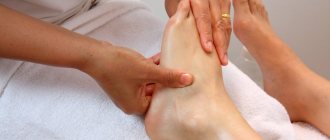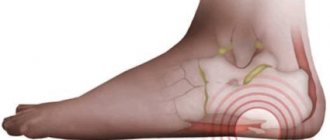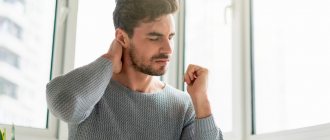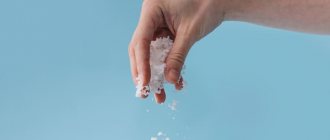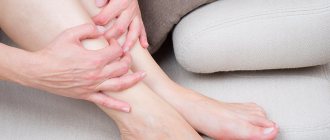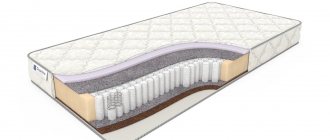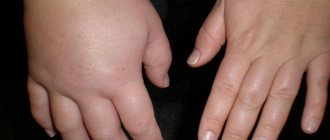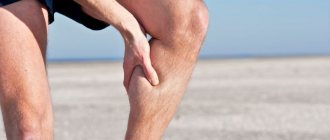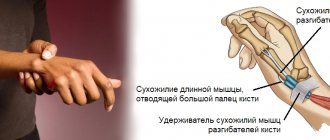Hypertonicity and immobility of muscles, which cause difficulty in movement - rigidity. The least serious manifestation is limited movement the next day after excessive physical exertion and muscle fatigue. Lactic acid and other metabolic products accumulate in the tissues. However, rigidity also occurs due to improper functioning of the nervous system. The disease has quite serious consequences (muscular paralysis of the whole body), so treatment should be started without delay.
What pathologies lead to stiffness?
- Protrusion, herniated disc and other diseases of the spine.
- Sore joints or their deformation.
- Infections.
- Ankylosing spondylitis.
- Lack of physical activity and muscle dystrophy.
- Lack of minerals in the body.
- Excessive amount of salts in the body.
- Tunnel syndrome.
- Frequent stress and emotional overload.
Rigidity can be provoked by alcohol abuse, sedentary lifestyle, etc.
Stiffness in the calf muscles of the legs and movements
Constant stiffness in leg movements can be caused by vascular insufficiency. This could be varicose veins of the lower extremities, atherosclerosis, obliterating endarteritis, etc. But much more often, stiffness of the leg muscles is associated with pathologies of the lumbosacral spine. Pairs of radicular nerves depart from it, which provide innervation to the lower extremities and coordinate the contractility of the leg muscles.
With osteochondrosis of the lumbosacral spine, destruction of the intervertebral disc occurs. As a result of protrusion, the radicular nerve is damaged. Radiculitis may occur, and subsequently nerve fiber degeneration. Compression of the sciatic nerve leads to a feeling of numbness in the lower extremities. Then, as the pathology progresses, there is a feeling of stiffness in the leg muscles.
Stiffness in the calf muscles can also be a consequence of varicose veins and venous insufficiency. But in most patients, this condition is associated with compression of the fibular nerve in the popliteal fossa. Tunnel syndrome is associated with the habit of sitting with one leg crossed over one leg.
What symptoms indicate muscle stiffness?
Often a person initially feels minor joint pain and slight discomfort in the back. Later, the pain intensifies, stiffness becomes more obvious, and spasms appear even at rest.
Exacerbation of the condition is provoked by neuroses, stress, and excessive emotional stress. A person tries to move less. An exacerbation can last for several days, and pain and discomfort cause night awakenings and insomnia.
With cervical radiculitis, when the neck muscles are spasmed, patients complain of throbbing pain in the back of the head.
People suffering from the disease often experience spinal curvature and lumbar lordosis. This changes the gait: the head and back are bowed forward, the arms are bent at the elbows and pressed tightly to the body.
Stiffness in the neck and shoulder muscles
Stiffness in the neck muscles can occur in the morning or occur after prolonged static tension, for example, when working at a computer. Both of these conditions can be a consequence of the same disease - osteochondrosis of the cervical spine.
Constant stiffness of the muscles of the neck and shoulders always indicates that the innervation process is disrupted due to compression of the radicular nerve. In this situation, the following pathologies should be excluded:
- osteochondrosis of the cervical spine;
- intervertebral disc protrusion;
- instability of the vertebrae or retrolisthesis;
- spondyloarthrosis and uncovertebral arthrosis;
- sprain of the ligamentous and muscular apparatus with subsequent cicatricial changes.
Sometimes stiffness appears when the glenohumeral joint of the bones is damaged. Arthrosis of the shoulder joint can also cause secondary stiffness of the muscles in the neck and collar area.
How to get rid of stiffness of movement
To relieve pain, it is often recommended to completely eliminate the load on the disturbing part of the body. If the joint and muscles are not stressed for too long, adhesions may form. After the acute period, you should begin to perform circular movements that involve the entire surface of the joint. Exercises should be performed at a comfortable air temperature. The body itself will gradually begin to secrete joint lubricant.
For any manifestations, active warming amplitude movements and fixation in static positions should be done. This is necessary for pumping muscles and activating the performance of joint cartilage.
Stiffness caused by physical overload is treated with massages, physiotherapy, heating, and exercises on a specific muscle. For more severe forms, the following are recommended: hydrotherapy, wax baths, hot wraps, diathermy. For unbearable pain, the doctor may prescribe pain-relieving injections, non-steroidal anti-inflammatory drugs, muscle relaxants, a course of manual therapy, and reflexology.
Stiffness in the back and body muscles
Constant stiffness of the body muscles is a symptom of systemic pathological processes. This may be a disorder of uric acid metabolism, renal pathology, edema syndrome, systemic lupus erythematosus, scleroderma, chondropathy and many other diseases. This is how rheumatism can manifest itself.
The appearance of stiffness in the back muscles is a signal to conduct an examination of the spinal column. Widespread osteochondrosis in the initial stages does not cause severe pain. It manifests itself in the form of muscle stiffness and loss of flexibility. If a feeling of stiffness appears exclusively in the morning, immediately after waking up, then this is most likely a symptom of ankylosing spondylitis.
For diagnosis, it is enough to take an x-ray of the spine. If characteristic protrusions are detected, a diagnosis of osteochondrosis is made. And if salts are deposited in the area of the endplates of the vertebral bodies, osteosclerosis or ankylosing spondylitis should be suspected.
What to do to prevent muscle stiffness from bothering you
For prevention, it is important to adhere to fairly simple rules:
- Adequate load every day.
- Proper nutrition that will maintain a sufficient amount of vitamins and minerals in the body.
- Quitting smoking, drinking alcoholic beverages, and narcotic substances.
- Timely treatment of infectious diseases.
- Examination by a doctor once every six months for timely detection of diseases.
- Avoiding situations and circumstances in which you can get hypothermia.
- An adequate attitude towards health is to prevent damage to the musculoskeletal system. For example, in icy conditions, wear comfortable shoes with non-slip soles. so as not to fall. Do not lift or jerk heavy weights in the gym. Do not lift heavy bags in the store.
- Sleep in a comfortable position; you can use an orthopedic pillow and mattress.
- If the work is sedentary, then do exercises during breaks.
- No stress and depression.
Causes of muscle and movement stiffness
The main reasons for muscle stiffness lie in the biochemical processes occurring in myocytes. These are real factories for producing the energy necessary to contract or relax muscles. Glycogen accumulates inside myocytes. This substance is the most energy-intensive and is released into the blood only in emergency situations. The second glycogen depot in the human body is the liver.
The reasons for stiffness of movement most often lie in biochemical disturbances in the structure of myocytes. They do not have the necessary supply of adenosine triphosphoric acid and glycogen. Their place is taken by breakdown products, metabolites, wastes and toxins. In diseases of the musculoskeletal system, various acids accumulate in the muscle structures, which provoke stagnation of lymphatic fluid. All this happens during those hours when the muscle tissue is at complete rest, i.e. during a person's sleep.
As soon as the muscle tissue begins to contract and relax, all waste products are eliminated and the person experiences relief from all symptoms. but this does not mean that the disease is receding. It is necessary to carry out complex treatment. First you need to identify the potential cause. Only after its elimination is effective therapy possible.
The causes of stiffness in the muscles of the legs, arms, back and neck may lie in the following influencing factors:
- diseases of large joints, such as osteoarthritis, arthritis, tendonitis, bursitis, etc.;
- osteochondrosis of the spine and its complications, such as protrusion of the intervertebral disc, hernia, instability of the position of the vertebral bodies;
- Bekhterev's disease;
- gout and other types of mineral metabolism disorders;
- salt deposits, formation of osteophytes;
- deformation of articular tissues;
- cicatricial changes in the ligamentous and tendon apparatus;
- general intoxication processes in the body (for example, against the background of a sore throat, ARVI or influenza);
- tuberculosis and other infectious diseases.
A common cause in young people is physical inactivity. This condition is associated with a lack of sufficient regular exercise on the main muscle groups. As a result, partial degeneration and loss of physiological properties of myocytes occur. It manifests itself as stiffness of movement, muscle weakness, fatigue, and inability to perform certain tasks associated with physical activity. For example, for a person suffering from physical inactivity, walking a distance of more than 2 kilometers can be a very difficult undertaking.
We will help:
- gain a feeling of lightness in the body,
- learn to relax and unwind,
- acquire plasticity of movements and gestures,
- to create freedom of bodily and emotional self-expression,
- learn to behave easily, openly and confidently,
- gain flexibility of thinking,
- increase social activity,
- gain flexibility in communication and non-verbal interaction,
- feel and accept other people,
- feel the rhythms and the partner,
- be conscious of your body,
- feel harmony in relationships with yourself and other people,
- feel yourself.
You can sign up for a consultation with a specialist or about how to remove clamps in the body using the feedback form. Our operator will contact you at a time convenient for you.
Shackled personality
Stable ideas about oneself, fixed in the body, give the personality a psychosomatic character, in which fixation is formed and adaptation to new conditions is limited. The body’s work is aimed at maintaining negative patterns of behavior, which is accompanied by tension and stiffness.
Clamps in the body affect social emotions and freedom of thought in relation to oneself and to the people around you, due to which the psychosomatics of the individual are enhanced.
In the absence of bodily freedom, a person unconsciously uses various psychological defense mechanisms, may misunderstand another person or situation, introduce additional meanings and make decisions in accordance with this. Such a person lacks flexibility of thinking and psychological flexibility in communication. Emotions and experiences are closed within the personality, which leads to self-inflation and excessive bias, coldness and callousness. In addition to the fact that it is difficult for a person to fully understand his own condition and understand himself, it is also difficult for him to sympathize with other people and be complicit in their experiences. Communication and communication between people is not built on the principles of compromise, cooperation and partnership; Manipulative relationships, forced concessions, and avoidance of openness and reciprocity occur more often.
Bodily restraint and lack of freedom of expression have a significant impact on the formation and development of personal and professional relationships.
What you should pay attention to:
- bodily stiffness,
- increased tension,
- inability to relax
- Difficulties in gesturing and non-verbal expression,
- emotional stiffness,
- psychological constraint,
- rigidity of thinking,
- social constraint,
- misunderstanding of other people's emotions and gestures,
- difficulties of empathy and sympathy,
- difficult to feel the rhythm (musical, dance, sports) or partner,
- Difficulties in understanding yourself and your own feelings.
The causes of stiffness in the body can be different:
Somatopsychic:
- features of the structure of the body (including hereditary and genetic), the specifics of the work of internal organs (including diseases and chronic diseases) and the muscular-ligamentous apparatus;
Psychosomatic:
- family conditions of development and upbringing in childhood (for example, pressure and restrictions on the child’s self-expression; frequent prohibitions and constant punishments; excessive demands and cultivation of feelings of guilt, etc.);
- natural, ecological conditions and terrain, the opportunity to attend sports and creative events, the influence of social groups (educational environment, environment of communication and pastime);
- destructive ideas and beliefs about yourself, your capabilities and other people (for example, “I can never ...”, “I have to work hard to ...”, “they love only for ...”, “all men ...”, “you have to endure ...”) .
Treatment of muscle stiffness - how to relieve discomfort?
Treatment for muscle stiffness begins with an examination and an accurate diagnosis. This condition is a clinical symptom of various pathologies. Each of them is amenable to different types of treatment. Therefore, a correct diagnosis is the shortest way to relieve the unpleasant sensations of stiffness.
We invite you to a free initial consultation. In our manual therapy clinic, you will see an experienced doctor who will be able to make an accurate diagnosis and prescribe effective treatment.
Therapeutic massage and osteopathy help relieve muscle stiffness. They enhance blood microcirculation and eliminate lymphostasis. For osteochondrosis of the spine and protrusions of the intervertebral discs, traction traction is used. These procedures increase the spaces between the vertebral bodies and completely relieve compression on the radicular nerves.
To achieve a long-term effect, it is necessary to conduct classes with a set of exercises of therapeutic gymnastics and kinesitherapy. They are developed by the doctor individually after assessing the condition of the muscular frame of the back, body and limbs.

